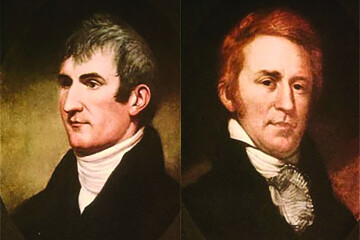Fiddler Music and Ardent “Spirits” on the Lewis and Clark Trail

In its scope and achievement, the Lewis and Clark Expedition of 1804-1806 stands as a giant among other major expeditions of the North American continent. The expedition carried a destiny as well as the flag of a young and vibrant nation. Travelling westward across hundreds of miles of uncharted wilderness – up the wide Missouri, over the Rocky Mountains and on to the Pacific Ocean. On foot, astride fleet Indian horses, and by canoe, pirogue, and keelboat, they pushed over formidable mountain landscapes, floated surging rivers, portaged over sagebrush plains laced with pads of prickly pear cactus and scorching heat , and endured numerous other hardships including drenching rains, hailstorms, abscesses, dysentery, colds, fevers, toothaches, sore feet, colic, pleurisy, and rheumatism. During the expedition’s numerous encounters with high adventure, suspense drama, disappointment, and fatigue, it was Cuzatte’s lively fiddle music and whiskey rations that served as prime catalysts in lifting one’s spirts during those difficult periods of travel enabling the expedition to proceed onward to the next horizon.
FIDDLER MUSIC AND DANCING ON THE TRAIL
The journals of the Lewis and Clark expedition site dozens of occasions when the men turned to music and dancing .for recreation and to celebrate holidays. There were also numerous occasions mentioned where the men danced for “diplomatic” reasons to various Indian tribes they visited. The natives were fascinated by this strange behavior of the visitors, and frequently requested, even insisted on, repeat performances. Clark made his servant, York, dance solo on several occasions. The musical entertainment, with dancing, undoubtedly served in helping to secure important information about the trail ahead, and for a peaceful transit through potentially hostile country. Music was provided by Pierre Cruzatte who played the fiddle exceptionally well and played popular dance tunes, most of them of unknown origin, and by ear. The dancers included all members of the expedition, with the exception of Lewis and Clark and Sacajawea. Lewis gave high marks to Cruzatte for his exceptional skill with the fiddle. On one occasion, he wrote “such as (men) were able to shake a foot amused themselves in dancing on the green to the music of which Cruzatte plays extremely well.”
The last dance with Cruzatte’s fiddle music took place on the banks of the Clearwater River on June 8, 1806, while waiting for the snow to melt from the trail crossing the Bitterroot Mountains. It was here where Lewis wrote in his journal that evening, “we had the violin played and they danced for the amusement of ourselves, and the Indians.”
ARDENT “SPIRITS” ON THE TRAIL
The liquor Ration Act of 1802 authorized by Congress for the military allowed for a one day liquor ration of one gill, a unit of liquid measure equal to one quarter of a pint or four ounces.) This allowed for a soldier’s ration for 32 days at the time of the Lewis and Clark expedition to be one gallon (932 gills to the gallon) of spirits of wine, rum, brandy, or whiskey.)
Spirits purchased by the captains prior to the expedition considered of 30 gallons of brandy, and 90 gallons of whiskey. Knowing that one gallon provides one ration at the legal rate for 32 days, 120 gallons for 37 expedition members, including two captains, on their departure journey to the West would have lasted for 104 days, way short of the Mandan villages. Yet, we know that the spirits, surprisingly, lasted until July 4, 1805.
The temptation to pilfer some whiskey from the whiskey barrel occurred on June 29. 1804 when Private Collins tapped the whiskey barrel while on guard duty and became intoxicated. Furthermore, he allowed Private Hall to join him in sampling the spirits. The discipline for this violation resulted in court martials and decreed 100 whip lashes for Collins and 50 for Hall.
A substantial unknown amount of the original purchase of liquor was contributed during native encounters, ranging from a dram (a unit of liquid measure equal to 1/8 fluid ounces) to four and a half gallons which the latter could have supplied the expedition with an additional four days of spiritous rations. The journals mention nine separate occasions where liquor was contributed as gifts to Indians which drained a substantial amount of the original stock purchased.
Conservative measures for the 1804-1805 winter stay at Fort Mandan were called for due to the depleted supply of liquor. There was no longer a daily issue of the previous daily gill ration as ordered by the captains, and each person was issued a dram per day, and only on appropriate occasions. Christmas day was an exception including those arduous days of toilsome hardships where each man was given a “gill of spirits.”
On July 4, 1805, a national day of celebration, Corp members at the Great Falls of the Missouri were issued a single dram of whiskey – their last of the ardent spirits for more than a year. Lewis wrote about the status of some of the men that evening, “…appeared a little sensible of its effects. The fiddle was played and they danced very merrily until 9 in the evening …they continued their mirth with songs and festive jokes and were extremely merry late at night.”
The dry spell of spirts for the Corps after the 4th would finally be replenished more than a year later on September 7, 1806, on their return trip when a gallon of whiskey was purchased on the lower Missouri River from boat travelers in the employ of Auguste Chouteau. Clark wrote in hid diary, “gave to each man of the party a dram which is the first spirituous liquor which has been tasted by them since the 4 of July 1805…”

